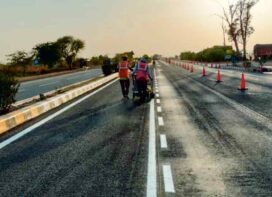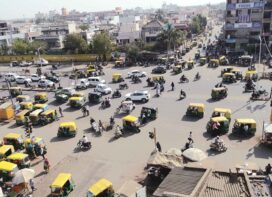
As a young volunteer in her teens, Neha Khullar, Director (Projects and Training) with MUSKAAN Foundation for Road Safety organised road safety awareness activities in her hometown in Jaipur. As her passion for road safety grew, she took upon to herself to build focused modules and training for specific segments in the society. She ensured that she built her own competencies first, by completing courses with Central Institute of Road Transport (CIRT), Pune, College of Traffic Management, Birmingham University and Safety Auditor course from IIT Delhi. As a nation, we must approach road safety with a sense of urgency, writes Neha
After dedicating more than a decade to advancing road safety and extensively traversing various states across India, including Odisha, Haryana, Punjab, Uttar Pradesh, Bihar, Gujarat, Karnataka, Telangana and Rajasthan, I have realized the urgent need to transcend conventional methods in our quest to significantly reduce road traffic accidents. What we need is systematic, sustainable, and standardized approaches essential for achieving desired outcomes.
The initial five years at the NGO were spent in community awareness programs on road safety through nukkad-nataks and incorporating local folk-art forms of Rajasthan for the semi-urban community. The NGO had developed one of the first road safety school education programs with the help of the domain experts and I was part of this initiative as a volunteer. This program implementation covered most of the schools in Jaipur both Public and Private.
Thereafter, the focus shifted to customized capacity building programs for different segments including educational institutes, commercial vehicles & school transport drivers, the police, engineers and general road users.
In road safety management, we talk about trauma response too. We talk about being a Good Samaritan and many states are coming up with cash rewards for being one. But the question is, are the first responders like the police and community actually trained to handle trauma or an accident on the road?
In today’s technologically-driven world, there is immense potential to revolutionize road safety through innovative solutions. Technology interventions can not only mitigate the risks associated with road travel but also enhance the efficiency of safety enforcement measures.

Capacity Building of enforcement agencies — the Police and the Transport Department:
Ensuring road safety requires a comprehensive understanding of traffic legislation, yet this domain often suffers from neglect and violations. It is vital for both road users and enforcement agencies to possess in-depth knowledge of these regulations. Bridging the gap between legislation and practical application is crucial for effective road management and safety enforcement.
Legislation in India on road traffic primarily focuses on regulating compliance among motorized vehicles, neglecting responsibility allocation for safe road usage to non-motorized traffic. The gap in law enforcement training and undefined authority poses challenges in traffic management and accident investigation. This deficiency frequently results in a biased approach, where the driver of the heavier vehicle is unfairly deemed guilty by default, without a thorough examination of the underlying causes and consequences of the accident, thus hindering the implementation of effective remedial measures. (As per MoRTH, the major cause of road traffic deaths is human error i.e. around 82%.)
To address this, comprehensive training programs are essential for law enforcement personnel, the police (investigation officers) and judiciary, to understand the intricacies of Motor Vehicle Driving Regulations-2017 and Motor Vehicle (Amendment) Act 2019. Additionally, there is a critical need for formal delineation of responsibilities between traffic police and road authorities, coupled with training in traffic engineering, traffic control devices and accident investigation procedures. This will ensure effective enforcement of road safety measures and improve the overall management of traffic incidents. Investing in capacity building within our systems is essential to equip field teams and officials with the necessary expertise.
Our experience in police training has revealed significant knowledge gaps in areas such as legislation, traffic engineering and accident investigation. Over the last six years, customized program developed by domain experts, has been conducted for the Police in Odisha, Haryana, Punjab, UP, Bihar, Gujarat and Rajasthan. From the data (approx. 10,000 police personnel) collected before and after the training, it was apparent that almost 90% of the trainees were unaware of the legislation and its amendments.

Road Safety School Education Program
Technology can play a pivotal role while integrating road safety education into school curricula. Tools like Interactive learning platforms, virtual simulations, educational apps and data analytics can engage students and impart essential knowledge and skills.
Educating children on elementary content of traffic signals and zebra crossing is not working any more as most of the Indian roads lack the basic infrastructure and have variety of vehicles operating. A school going child is also a road user. The Ministry can come up with a comprehensive & standardized module with scope for customisation as per geographical conditions and also devise a mechanism to equip the educators or NGO’s to follow the prescribed curriculum.
At Muskaan NGO, we developed age-specific curriculum and collated in a handbook for teachers with the help from the police, doctors and lawyers. The handbook has all relevant information regarding the school education program in a format suitable to teachers. It is based on the approaches used by qualified teachers. The learning modules are for grades six to eight and nine to twelve. Pilots have been conducted in 12 government schools in Varanasi, UP and in 44 Indian Air Force schools across India. Teachers were trained for three days and orientated on all aspects of road safety, teaching methodology and use of handbook during their regular academic session.
Strengthening the emergency Response
The responsibility of rescuing the accident victims also falls in the kitty of Police along with ambulance drivers and emergency medical technicians present in an ambulance. The question is whether these first responders, in addition to the community, are actually trained to handle trauma in survivors?
Along with working on policy level to reduce the response time of ambulance and developing accessible trauma centers what needs to be done is to build the capacity of first responders i.e. police, ambulance drivers and emergency medical technicians in trauma response through a standardized curriculum and a recognized competent authority. The NGO has organized training programs for this segment too in Rajasthan, New Delhi and some parts of Haryana.

Training Mechanisms for Two-Wheeler Riders:
A significant portion of road traffic accidents involves two-wheeler riders. (As per MoRTH, 75000 two-wheeler riders died in road traffic crashes in the year 2022). With most of the two-wheeler vehicle population coming from rural / semi urban areas and mostly using National and State highways, we need to bring in innovative traffic engineering solutions like soft crash barriers for segregating this vulnerable traffic. Here again, developing interactive training modules and virtual simulations specifically designed for two-wheeler riders can help.
Standardizing Training Modules:
Standardization of training modules for NGOs, civil societies, and consultancies working on road safety needs to be looked at. Establishing a national-level institute to define syllabi and content, methodology along with providing access to the latest technology, can significantly enhance the effectiveness of safety awareness campaigns. The best practices should be shared and used at a wider level reaching out to rural communities too, as major road traffic accidents and fatalities are happening in semi urban areas.
In conclusion, addressing the intricacies of road safety necessitates a holistic approach that harnesses the power of technology, strategic capacity building, and targeted education initiatives.
 TrafficInfraTech Magazine Linking People Places & Progress
TrafficInfraTech Magazine Linking People Places & Progress


